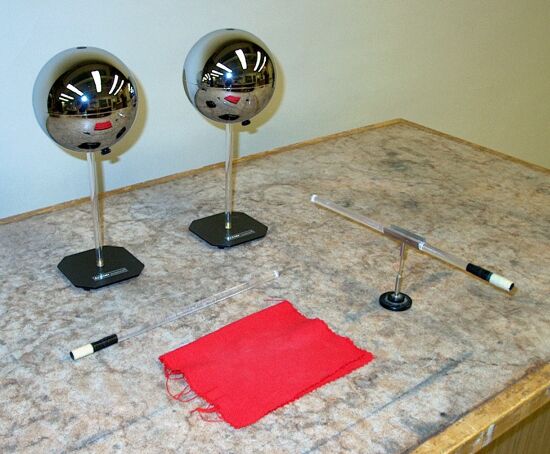
Charge one plastic rod by rubbing it with the red felt, and place it on the swivel stand. Move the spheres so that they are touching each other, and touch them to ground them (and thus remove any net charge). Charge the other plastic rod and hold it near one of the spheres on the side opposite where it touches the other sphere. With the rod still held close to the sphere, break the contact between the spheres. One at a time, bring the spheres close to the rod resting on the swivel stand. One sphere will repel the rod, the other will attract it.
You can also do this by charging a single rod, using it to induce charge in the spheres, then placing it on the swivel and bringing the spheres close to it. You can, of course, also bring the swivel over to each sphere in turn, though this is not as easy.
When you bring the charged rod close to one of the metal spheres, the rod either repels all like charges in the sphere, or attracts all opposite charges, depending on the sign of its charge and whether you prefer to speak of electrons or “holes” moving in the material. Plastic rubbed with felt, shown above, charges negative. So holding the plastic rod near one of the spheres drives electrons to the other side of the sphere. Since the spheres are conductive, charge can move over their entire surface, and if they are touching when you do this, then electrons can travel from the first sphere to the second. When you separate the two spheres, the far sphere is thus left with a net negative charge, and the sphere next to the rod is left with a net positive charge. After you separate the spheres, then, the one that was near the plastic rod will attract the rod, and the other sphere will repel the rod. (You could do this with a glass rod rubbed with silk, which would charge positive. The spheres would thus carry opposite charges to those in the example above, but the near one would still attract the rod, and the far one would still repel it.)
Important note!
This demonstration works, but it can be a little tricky. In the example above, the positively charged sphere always attracts the rod. The negatively charged sphere should repel the rod. It does this, unless you bring the rod too close to it (or it too close to the rod). If the rod and sphere are too close to each other, then the charge on the rod polarizes the sphere in similar fashion to the way it did at the beginning of the demonstration. It induces a positive charge on the portion of the sphere next to the rod, and a negative charge on the far side of the sphere. It is thus attracted to the sphere instead of being repelled, making it appear that the demonstration does not work. The attractive force is a monopole-induced dipole, or ion-induced dipole force, which scales as the inverse fifth power of the distance between the ion and the object in which the dipole is induced. The repulsive force that the demonstration relies on is the Coulomb force between the charge on the rod and the charge on the sphere, or a monopole-monopole, or ion-ion force, which scales as the inverse square of the distance between the centers of charge. Thus, the repulsive force decays much more slowly with distance than does the attractive force. If you do not hold the rod and sphere too close to each other, the repulsive force dominates, and the sphere repels the rod.
Therefore, when performing this demonstration, you should be careful not to bring the rod too close to the spheres (or the spheres too close to the rod).
For reference, the table below gives the various types of electrostatic forces, with their relationships to distance, r, and also the way their energies scale with distance, r. These relationships are for aligned dipoles, and do not represent an average over all orientations. I arrived at this table with the help of Berry, R. Stephen; Rice, Stuart A. and Ross, John, Physical Chemistry (New York: John Wiley & Sons, 1980), pp. 411-415, and of Murrell, John N.; Kettle, Sydney F. and Tedder, John M. The Chemical Bond (Chichester: John Wiley & Sons, 1985), pp. 290-293.
Monopole-dipole Dipole-dipole Monopole-induced dipole Dipole-induced dipole Atoms and molecules that have no permanent dipole moment can have instantaneous dipole moments as a result of fluctuations in their charge distribution. This gives rise to London dispersion forces, which, for distances shorter than a few hundred angstroms, scale as dipole-induced dipole forces do. These forces involve correlation between the electrons on the two atoms or molecules, and are quantum mechanical in nature. Because of the finite speed of light, at distances greater than a few hundred angstroms, these forces scale as 1/r8 (and the energies as 1/r7). Of course, in this demonstration, we are dealing with forces between macroscopic objects on distance scales that are huge compared to this. We also have a situation in which one object carries a net charge, so, as noted above, the forces that concern us are monopole-monopole and monopole-induced dipole forces. In any case, the table above gives us a good idea of how these forces scale with distance relative to each other.